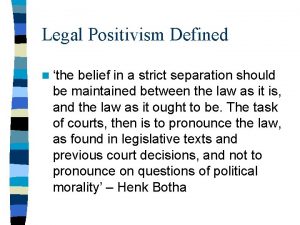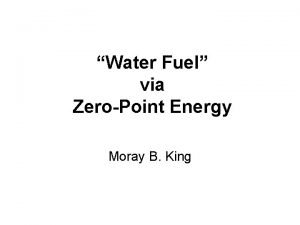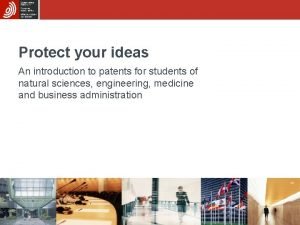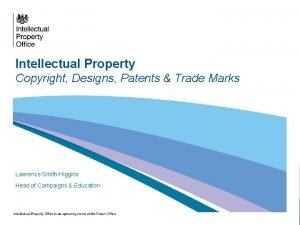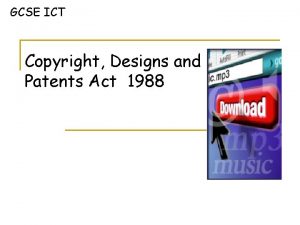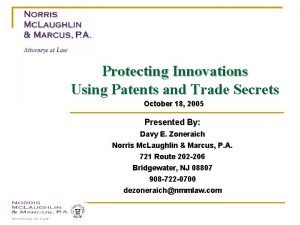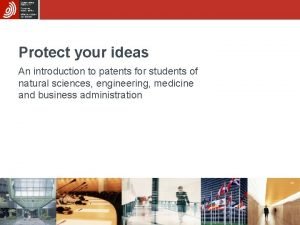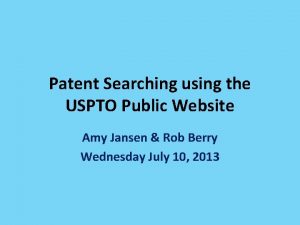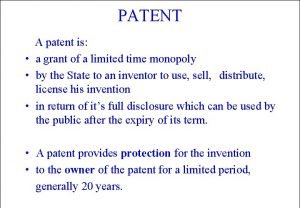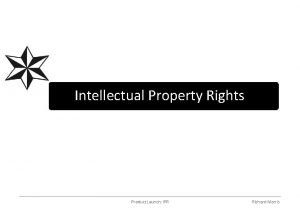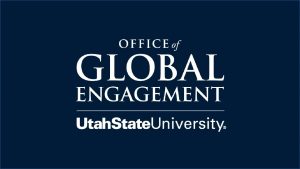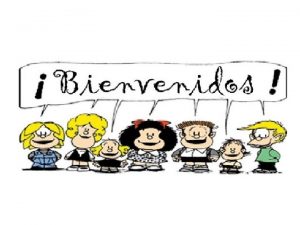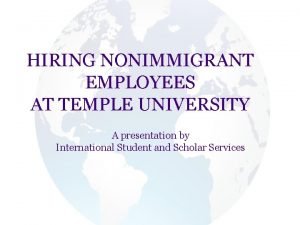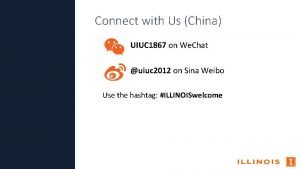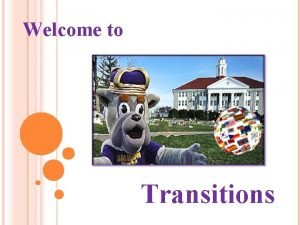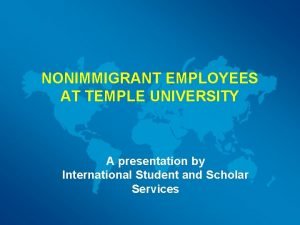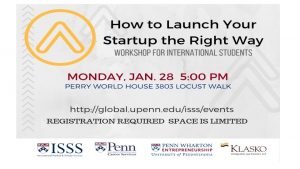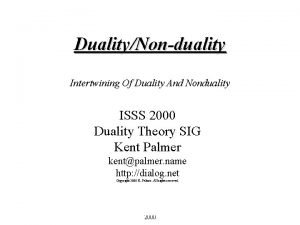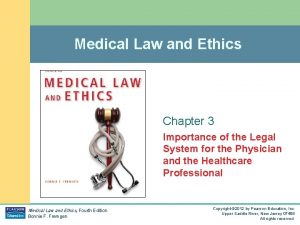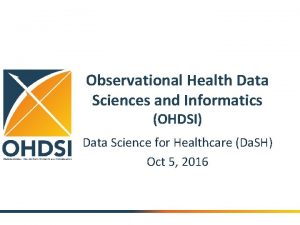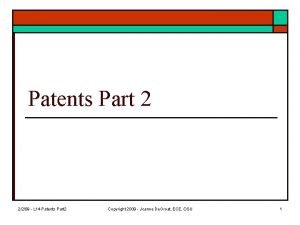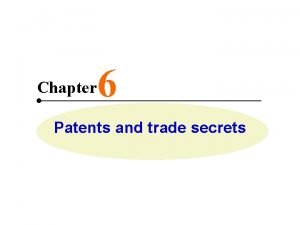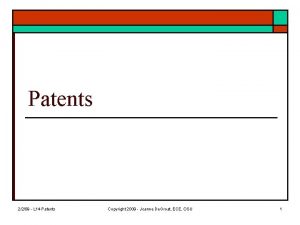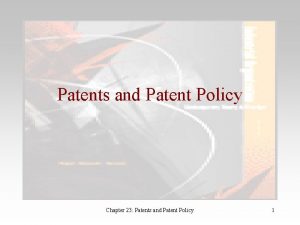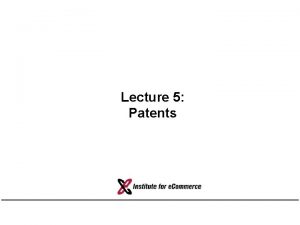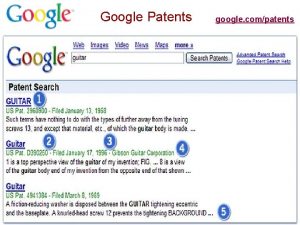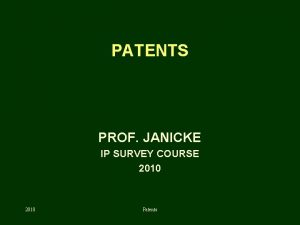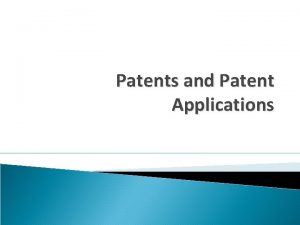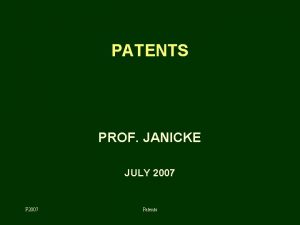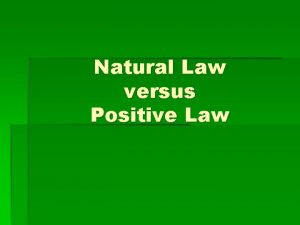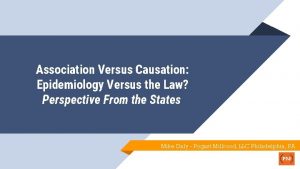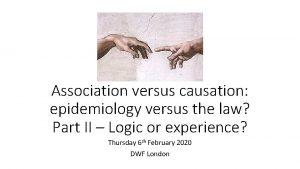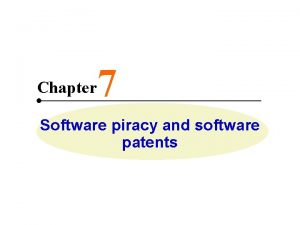Software Patents Informatics versus Law Ji Zlatuka ISSS























- Slides: 23

Software Patents - Informatics versus Law? Jiří Zlatuška ISSS 2004, Hradec Králové, April 5, 2005

Problems with software patents • Informatics fuels processes whose importance lies beyond just a technical discipline • Links to inventive processes and innovation • Industrial-age concepts crucial to innovation are patents and protection of innovators rights • These concepts are difficult to apply straightforwardly

Changing paradigms • Employing energy replaced by using information • Knowledge, innovation, and creativity • New ideas vs. duplication of material products • Intellectual property rights as compared with physical ownership

Changing paradigms • Copyright as protection of expressing ideas, not ideas as such • Patents are more linked to the intellectual contents of an innovation • Patents are mainly tools of preventing a knowledge to be freely used, making replication of existing knowledge difficult

Inventions and limited monopolies • In the U. S. tradition, Congress is empowered by the Constitution "to Promote the Progress of Science and useful Arts, by securing for limited Times to Authors and Inventors the exclusive Right to their respective Writings and Discoveries. " • Patent office was charged with the enforcement of a bargain: inventors give up their secrets, publishing them for all to see and absorb, and in exchange they get 20 -year governmentsanctioned monopolies on their technologies

Patent doctrines - 1 Practical and repeatable problem solutions • All kinds of ideas can be patented, provided that they are repeatable independently of participating persons and achieve a determined effect in the material world. Purely mathematical solutions are acceptable, but the claims must be tied to practical applications, potentially leading to very long lists of claims. This doctrine is favored by leading theoreticians of both the USPTO and the EPO.

Patent doctrines - 2 The Technical Field aka Applied Natural Science • The "technical field" is the field of engineering understood as applied natural science. An invention must teach a new way of using natural forces to directly achieve a tangible result. "Computational or organisational rules" designed to solve problems posed by mathematical models (such as the Turing machine) are not technical in this sense, no matter whether the model in question can be mapped onto a physical structure or not. • This doctrine was developed mainly by German courts of law up to the 80 s, and it can be found in law commentaries, examination guidelines and court decisions up to the year 2000. The Eurolinux Alliance opposing European e-patents demands that this doctrine be systematically applied in the future.

Patent doctrines - 3 Abstractions in their Original Form • This doctrine allows even the patenting of purely abstract mathematical methods without a practical application. • The question of patentability is no longer asked. • The discussion is shifted to enforceability: what kind of objects can constitute a patent infringement?

Patent doctrines - 4 Dynamic Concept of Technical Character • "Apply all three doctrines in an case-by-case approach, drift toward unlimited patentability in spiral development. For the sake of "legal security" (= prevention of resistance from "conservative" courts of law), confirm this course from time to time by fuzzy laws and directives. “

Troubles with patents in the information setting ? • Information goods recognised as part of public communication process • May not be touched by patents, no matter what is written in the patent claim and no matter whether they are technical or not • Only industrially produced material goods (marginal production cost > 0) can infringe on patents • Not only the private sphere but also the sphere of public communication, including direct application of information goods on an ordinary computer, is off-limits to patents

Troubles with patents in the information setting ? • Question about claims to abstract-logical constructions can be left open • “Difficulty of Invention” criteria applied in order to eliminate trivial patents / inventions • “Post-industrial” innovations require use of abstract calculus, not results of experiments and/or costly development of prototypes / physical plants, etc.

Dilemma • Patents fuelling innovation and invention • Patents associated with machines, apparatus, or a system • Patents are not prepared to handle abstractions based on logic and bits • Patents are tied to a model of invention, this is changing with shift from energy to information

An example of curious patents U. S. patent No. 5, 965, 809: A method of bra size determination (by direct measurement) issued to inventor Edward Pechter in 1999

Software patents • Microsoft’s first patent from 1986 was not a software one (that only came in 1988) • „Look and Feel“ court suits at the end of 80’s - Apple sued Microsoft in 1988, for a „desktop metaphor“ - Lotus sued Borland in 1990, for a pull-down menu use (rejected by Supreme Court by 4: 4) • Compression and encryption • At the end of 1997 Jeff Bezos comes with a patent for „one -click ordering“ (competition with Barnes&Noble) • Using concepts from material products and processes into the area of algorithms and computational procedures

Software patents - 2 • SBH, a patent litigation company sued Yahoo on behalf of an Australian inventor for patent infringement for an “integrated interface for vendor/product oriented internet Websites. ” (on/line shopping) using an universal shopping cart operated from a single place on the web site, i. e. a universal shopping interface for several sites. • Priceline. com patented internet auctions (suit against proti Expedia. com) • Sightsound. com filed a suit against several companies selling music and video on-line • A Boeing programmer patented software correction for two -digit dates when changing century, and seeks compensation from about 700 big companies.

Software patents - 2 • In 1998 Judge Patti Saris rejected a suit against State Street Bank (computerized strategy of managing a multitiered portfolio) • Judge Saris: „Mental processes, and abstract intellectual concepts, are not patentable, as they are the basic tools of scientific and technological work. “ • Court of Appeal reversed this in 1998. • This was followed by Bezos’ patent infringement suit against Barnes&Noble

Competency problems and inadequacy of the mechanism • Tools for physical world applied to abstract processes • Napster and distribution of digitized recordings • Metaphors and paradigms which do not work • Intellectual property rights protection as a potential prevention of developing new applications? • Patent offices obviously not understanding the issues of developing software and/or algorithms

European e-patent • European Council attempts to introduce software patents • Several parliaments passed resolution against • European Parliament so far by-passed by the Ministers

Source code as a manifestation of free speech De. CSS – program for decoding DVD - Program distributed as a text containing source code - Suit filed against WWW servers linking to De. CSS - 1999: decision based on the assuption that majority of software is not expression of an idea - 2000: progeams express information and ideas about programming - 2001: a suit filed covering also the object code - Plaintiff: De. CSS is a kind of a „terrorware“, which may crash planes or software in hospitals may stop functioning - August 2003 Califonia court of justice admitted that business secret protection can prevail over the freedom of expression, and prohibited web sites from accessing these web sites. In is unlear to what extent this breaches copyright prevention.

Dimitrij Skljarov and password removal from protected PDF files July 2001: a Russian programmer from Elcomsoft company arrested after a talk about principles of the password removal from PDF files - program does not de-crypt files, it only works as a plug-in which gets the password from a parent Acrobat program - problem containing dilemma between breaching a law and providing a tool which allows to breach the law - jurisdiction problem vis-à-vis programs developed in abroad - problem of legitimate use of circumventing blocking mechanisms, e. g. for reading a text by a legitimate user on a computer where original application software cannot run

„Digital Millenium Copyright Act“ • American Congress law enacted in 1998 • Passed unanimously by both the House of Representative and the Senate • Strong support by BSA (Adobe, Microsoft, Novell, Network Associates) and the Association of American Publishers • Opposition by Electronic Frontier Foundation and former Digital Future Coalition • It is illegal to by-password protection even when excercising one’s own rights, not only when breaching copyright owned by someone else

Problematic points in connection of a strong protection • Fair use – copies for personal use • Temporal copies emerging as a consequence of a legitimate activity (e. g. , http proxy cache or storing a temporal copy of an e-book in computer memory) • A right to sell purchased license without a consent of the initial seller • Using digital material for distance education in the same way as when using it in a closed environment • Exceptions needed for libraries and archiving purposes • A need for permitting to by-pass blocks by an authorized user in a different environment

Informatics as a basis for doctrine re-formulation • New approach needed outside the scope of just an applied computational discipline • Informatics providing basis for the shift towards the Information age • Informatics providing methodology tool needed outside of the technical / mathematical discipline • General Informatics education / concept development important in wider sense • No coherent approach is available, and possible damage comes from outside the field
 Natural law vs positivism
Natural law vs positivism Stanley meyer
Stanley meyer Advantages and disadvantages of patents
Advantages and disadvantages of patents What is the copyright designs and patents act 1988
What is the copyright designs and patents act 1988 What is the copyright designs and patents act 1988
What is the copyright designs and patents act 1988 Trade secrets examples
Trade secrets examples Advantages and disadvantages of patents
Advantages and disadvantages of patents Uspto
Uspto Patents are granted for a new
Patents are granted for a new Patents
Patents Amanda castillo usu
Amanda castillo usu Docencia isss
Docencia isss Temple isss
Temple isss Uiuc isss
Uiuc isss Udap jmu
Udap jmu Temple isss
Temple isss Isss upenn opt
Isss upenn opt Isss kent
Isss kent Newton's first law and second law and third law
Newton's first law and second law and third law Newton's first law and second law and third law
Newton's first law and second law and third law V=k/p
V=k/p Boyle's law charles law avogadro's law
Boyle's law charles law avogadro's law Chapter 3 healthcare laws and ethics
Chapter 3 healthcare laws and ethics Observational health data sciences and informatics
Observational health data sciences and informatics
